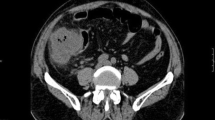Conclusions
Twenty-two carriers of E. histolytica, who had abdominal symptoms and who had no organic condition, other than amoebiasis, which might have produced those symptoms, were given a therapeutic test.
-
(1)
While 19 of the carriers were improved for a short time on the rest, suggestion, and “tonic effect” of therapy, only 6 (27 per cent) patients were freed from abdominal symptoms by the treatment when they were studied three months or longer after its completion. Amoebiasis should be looked for in all patients with gastro-intestinal complaints, but too striking clinical improvement should not be expected from the amoebicidal treatment of carriers. This statement is in contradiction to the usual teaching.
-
(2)
All of the patients who were relieved of their abdominal complaints by treatment had complained in such, a manner that their abdominal syndromes could be described clinically as those of “the unstable colon.”
-
(3)
Many of the patients, who were not relieved for a relatively long period by amoebicidal therapy, responded for a time to sedatives, bowel management, and antispasmodics.
All carriers of E. histolytica should be rid of their parasites for public health reasons and to avoid the possibility of later complications in the carriers themselves.
Similar content being viewed by others
References
Craig, C. F.: Amebiasis and Amebic Dysentery. Baltimore, Charles C. Thomas, Publisher, p. 122, 1934.
Paulson, M. and Andrews, J.: The Role of Symptoms and Signs in Amebiasis.Ann. Int. Med., 13:64, July, 1939.
Craig, C. F.: Amebiasis and Amebic Dysentery. Baltimore, Charles C. Thomas, Publisher, p. 121, 1934.
Hegner, R.: Absence of Tissue Invasion in Monkey Carriers of Endamoeba Histolytica.Am. J. Trop. Med., 15:41, Jan., 1935.
MacCallum, W. G.: Personal communication.
Craig, C. F.: The Pathology of Amebiasis in Carriers.Am. J. Trop. Med., 12:285, July. 1932.
Hiyeda, K. and Suzuki, M.: Pathological Studies of Human Amoebic Ulcers, Especially Those of Carriers.Am. J. Hyg., 15:809, May. 1932.
Dobell, C.: The Amoebae Living in Man. London, John Bale, Sons amp; Danielsson, Ltd., p. 39, 1919.
James, W. M. and Deeks, W. E.: The Etiology, Symptomatology and Treatment of Intestinal Amebiasis.Am. J. Trop. Med., 5:97, March, 1925.
Andrews, J. and Atchley, F.: Negative Occult Blood Tests in Carriers of the Dysentery-Producing Endamoeba Histolytica.J. A. M. A., 99:1340. Oct. 15. 1932.
Hakansson, E. G.: On the Effectiveness of Carbarsone as a Remedy for Amoebiasis.Am. J. Trop. Med., 18:245, May, 1938.
Lynch, K. M.: Prolonged Influences and Complications of Intestinal Amebiasis.J. A. M. A., 103:1147, Oct. 13, 1934.
Author information
Authors and Affiliations
Rights and permissions
About this article
Cite this article
Howard, J.T. The clinical significance of the carrier state in amoebiasis. American Journal of Digestive Diseases 6, 506–509 (1939). https://doi.org/10.1007/BF02997027
Issue Date:
DOI: https://doi.org/10.1007/BF02997027




